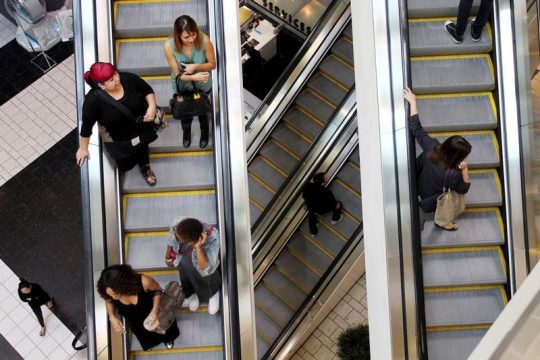WASHINGTON (Reuters) - U.S. consumer spending increased solidly in June as households spent more at restaurants and on accommodation, building a strong base for the economy heading into the third quarter, while inflation rose moderately.
Other data on Tuesday showed employers boosting benefits for workers in the second quarter, but wage growth slowed down. With savings at lofty levels and lower taxes increasing take-home pay for some workers, consumer spending is likely to remain strong this year and allow the Federal Reserve to continue gradually raising interest rates.
Fed officials were due to start a two-day meeting later on Tuesday.
"More spending on 'wants', not 'needs', is always a good sign of consumer confidence," said Jennifer Lee, a senior economist at BMO Capital Markets in Toronto. "As long as incomes continue to rise and job creation remains strong, consumer spending should remain solid over the remainder of the year."
The Commerce Department said consumer spending, which accounts for more than two-thirds of U.S. economic activity, rose 0.4 percent last month. Data for May was revised up to show consumer spending advancing 0.5 percent instead of the previously reported 0.2 percent increase.
Last month's increase in consumer spending was in line with economists' expectations. The data was included in last Friday's second-quarter gross domestic product report, which showed consumer spending accelerating at a 4.0 percent annualized rate during that period after a pedestrian 0.5 percent pace in the first quarter.
The economy grew at a 4.1 percent rate in the second quarter, almost double the January-March period's 2.2 percent pace and the strongest performance in nearly four years. June's increase in consumer spending sets it on a higher growth path heading into the third quarter.
Consumer spending last month was boosted by spending at restaurants and on accommodation. Spending on goods was unchanged after surging 0.9 percent in May. Spending on services accelerated 0.6 percent after rising 0.3 percent in May.
Prices continued to steadily rise last month. The personal consumption expenditures (PCE) price index excluding the volatile food and energy components gained 0.1 percent in June. It had risen by 0.2 percent in the prior month.
That kept the year-on-year increase in the so-called core PCE price index at 1.9 percent for a third straight month.
The core PCE index is the Fed's preferred inflation measure. The core PCE hit the U.S. central bank's 2 percent inflation target in March for the first time since December 2011. The Fed is expected leave interest rates unchanged on Wednesday after increasing borrowing costs in June for the second time this year. It has forecast two more rate hikes by December.
U.S. financial markets were little moved by the data.
MODERATE WAGE GROWTH
Spending in June was supported by a 0.4 percent increase in personal income, which matched May's increase. Savings edged up to $1.050 trillion last month from $1.047 trillion in May.
In a separate report on Tuesday, the Labor Department said its Employment Cost Index, the broadest measure of labor costs, rose 0.6 percent after an unrevised 0.8 percent advance in the first quarter. That pushed the annual increase in the ECI to 2.8 percent, the biggest gain since September 2008.
The ECI rose 2.7 percent year-on-year in the first quarter.
Wages and salaries, which account for 70 percent of employment costs, rose 0.5 percent in the second quarter, retreating from a 0.9 percent surge in first three months of the year. Wages and salaries were up 2.8 percent in the 12 months through June, also the biggest annual gain since September 2008.
Private sector wages and salaries rose 0.6 percent in the second quarter after jumping 1.0 percent in the January-March period.
Economists expect a significant acceleration in wage growth in the second half of the year, boosted by a tightening labor market. The labor market is considered to be near or at full employment, with a 4 percent jobless rate.
Benefits for all workers increased 0.9 percent in the April-June quarter, the biggest gain in four years, after rising 0.7 percent in the first quarter. They were up 2.9 percent in the 12 months through June, the largest increase since December 2011, after rising 2.6 percent in the year to March.
(Reporting by Lucia Mutikani; Editing by Andrea Ricci)
